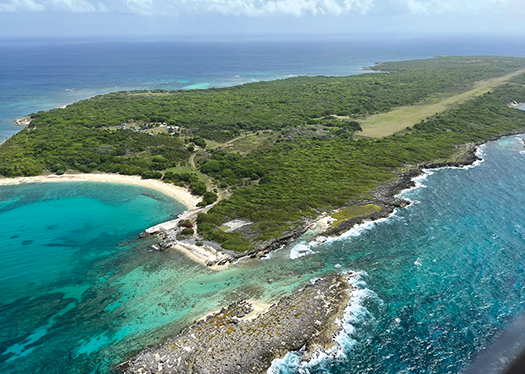
The Honduran government plans to build a maximum-security prison on Cisne Grande, the largest island in the three-island El Cisne chain. (Photo by Daniel Germer]
The Honduran government in 1991 conferred protected-area status on the Islas del Cisne, or Swan Islands, a three-island archipelago 250 kilometers (155 miles) off the country’s northern coast, with the aim of preserving biodiversity through research, environmental education, and ecotourism.
Recently, however, the government announced that the largest of the islands, Cisne Grande, or Great Swan, will serve an additional purpose: to house the country’s most dangerous criminals in a maximum-security prison it plans to build there. Her country beset by gang violence, Honduran President Xiomara Castro is adopting hardline tactics similar to those of neighboring El Salvador. There, President Nayib Bukele last year imprisoned 66,000 people—nearly one of every 100 citizens—as part of an anti-gang crackdown, giving El Salvador the world’s highest incarceration rate.
A new feature of Castro’s strategy is her plan to imprison 2,000 gang leaders on Great Swan, which—like the chain’s other two islands, Little Swan and Booby Cay—is uninhabited, though the navy has a presence there.
The June 22 announcement came as a surprise, since her progressive-leaning administration had spoken in the past of plans for prison reform rather than expansion of the correctional system. The apparent about-face occurred amid a government investigation of the country’s largest prisons that was spurred by the gang-related killing on June 20 of 46 inmates in a single Honduran women’s prison in Tamara, located a half-hour northwest of Tegucigalpa.
Weapon-filled prisons
The investigation, which involved the Honduran Defense Ministry, revealed that the country’s maximum-security facilities were rife with contraband firearms, knives, other weapons, and cash. Members of the Castro administration appear to hope that by establishing an island prison, they will send a strong message to leaders of the country’s criminal gangs.
“Honduras has a sought-after island called Roatán,” said National Defense Secretary José Manuel Zelaya, referring to a Caribbean island whose coral reef marine reserve is prized by divers. Added Zelaya, a nephew of Castro and her husband, former Honduran President José Manuel Zelaya: “Now we are going to have a feared island—Isla del Cisne.”
Secretary Zelaya has pledged the prison project will meet all government environmental permitting requirements and “reduce the environmental impact to zero.” He says the Honduran Joint Chiefs of Staff are currently evaluating plans for the facility in advance of putting the project up for bids.
Lucky Medina, Castro’s secretary of natural resources and environment, seconds the view that the facility can be built in keeping with Honduran environmental requirements. He says there is enough space on the island to “build a penal colony without cutting down a single tree.” And he argues the environmental-impact review process can be used not only to ensure minimal ecological disturbance, but also to study “potential land use on the Cisne Islands and the current state of the coral reef.”
Medina asserts that in gauging the impact of construction on Cisne Grande, the government can draw on the example of Roatán’s West Bay area, home to that island’s main resorts. West Bay, he says, illustrates how development can occur in a marine reserve “without causing serious harm to biodiversity.”
Logistics, cost, and impacts
Despite such assurances, opposition political parties, environmental groups, and academics have criticized the prison project. Some data released by the government in support of its decision is over a decade old, notes Claudia Guerrero, coordinator in Honduras of the Healthy Reefs for Healthy People Initiative, an international effort to boost conservation of the Mesoamerican Reef.
Meanwhile, biologist Mayra Servellón cites the considerable environmental value of the three islands in the El Cisne chain, which constitutes the El Cisne Islands National Marine Park. The archipelago is home to flora and fauna not found on the mainland and is one of the few virtually intact areas of the Mesoamerican Reef system, she says. In all, the El Cisne archipelago has 171 species of vascular plants, 29 types of corals, 65 bird species, six reptile varieties, and 54 fish species, says Servellón, a biology faculty member at Autonomous National University of Honduras (UNAH).
Other experts point to logistics and cost—among them Estefanía Calix, a biologist who advises construction companies on environmental issues and has visited the Cisne Islands. She cites the distance of the archipelago—14 hours by boat—and the difficulty and expense of shipping food and other provisions from the mainland, not to mention delivering what will be needed to assemble electric-power, sewage-treatment, and desalination infrastructure.
Thus far, the Castro administration has not held public hearings in connection with feasibility and environmental-impact studies related to the project. Nor, as of press time, had the government announced a timetable for the facility’s design and construction.
- Lizz Gabriela Raudales